

Compact Muon Solenoid
LHC, CERN
| CMS-PAS-EXO-21-016 | ||
| Search for heavy neutral resonances decaying to τ lepton pairs in pp collisions at √s= 13 TeV | ||
| CMS Collaboration | ||
| 4 June 2024 | ||
| Abstract: A search for heavy neutral gauge bosons (Z') decaying to two tau leptons is performed in proton-proton collisions at √s= 13 TeV at the CERN LHC. The data were collected with the CMS detector and correspond to an integrated luminosity of 138 fb−1. The yields of candidate events are found to be consistent with the predictions from standard model processes. Limits on the production cross section times branching fraction of the Z' as a function of the Z' mass are set at the 95% confidence level. For a narrow resonance in the sequential standard model scenario, a Z' with mass below 3.5 TeV is excluded. This is the most stringent limit to date from this type of search. | ||
|
Links:
CDS record (PDF) ;
CADI line (restricted) ;
These preliminary results are superseded in this paper, Submitted to PRD. The superseded preliminary plots can be found here. |
||
| Figures | |
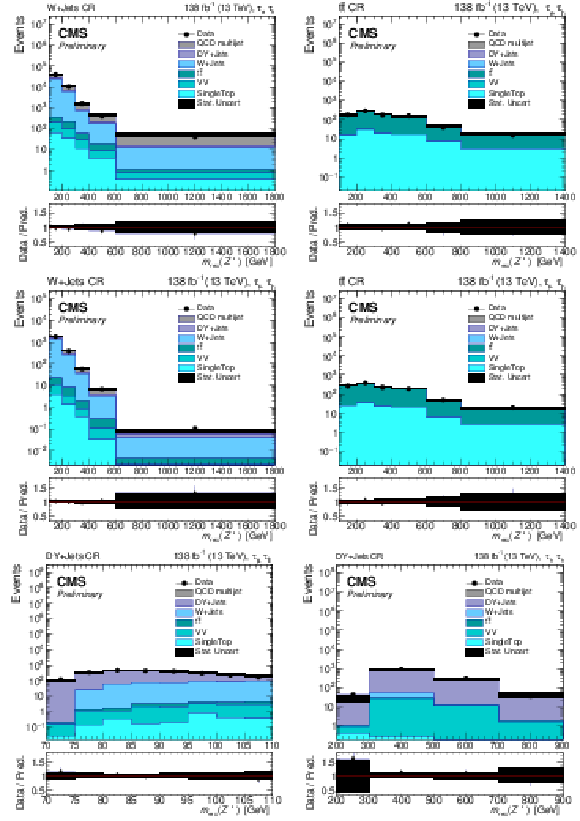
png pdf |
Figure 1:
Pre-fit reconstructed mass distributions for the (upper row) τeτh, (middle row and lower row left) τμτh, and (lower row right) τhτh channel. In the upper and middle rows, the W+jets ( t¯t) CR is shown in the left (right) column. The lower row shows the DY CR for the τμτh (τhτh) channel in the left (right) column. The background contributions appear as stacked solid-filled histograms, while the observed data are shown as black solid markers with error bars. Overflow counts are included in the last bin. The grey shadow band represents the statistical uncertainty in the background prediction based on the number of simulated events and scale factor uncertainties. The lower panel of each plot shows the ratio of data to predicted background yields. |
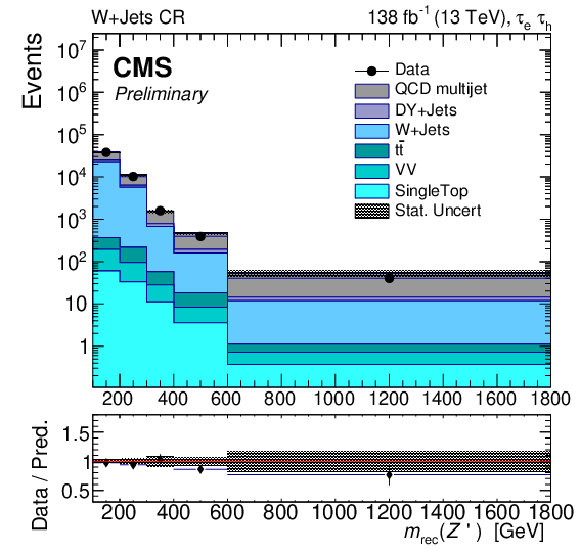
png pdf |
Figure 1-a:
Pre-fit reconstructed mass distributions for the (upper row) τeτh, (middle row and lower row left) τμτh, and (lower row right) τhτh channel. In the upper and middle rows, the W+jets ( t¯t) CR is shown in the left (right) column. The lower row shows the DY CR for the τμτh (τhτh) channel in the left (right) column. The background contributions appear as stacked solid-filled histograms, while the observed data are shown as black solid markers with error bars. Overflow counts are included in the last bin. The grey shadow band represents the statistical uncertainty in the background prediction based on the number of simulated events and scale factor uncertainties. The lower panel of each plot shows the ratio of data to predicted background yields. |
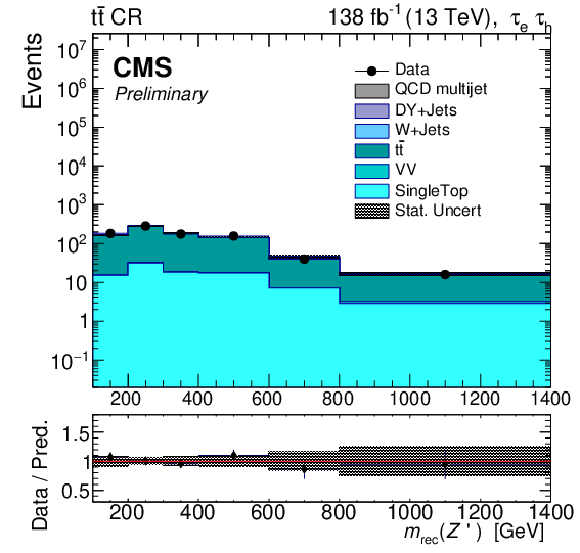
png pdf |
Figure 1-b:
Pre-fit reconstructed mass distributions for the (upper row) τeτh, (middle row and lower row left) τμτh, and (lower row right) τhτh channel. In the upper and middle rows, the W+jets ( t¯t) CR is shown in the left (right) column. The lower row shows the DY CR for the τμτh (τhτh) channel in the left (right) column. The background contributions appear as stacked solid-filled histograms, while the observed data are shown as black solid markers with error bars. Overflow counts are included in the last bin. The grey shadow band represents the statistical uncertainty in the background prediction based on the number of simulated events and scale factor uncertainties. The lower panel of each plot shows the ratio of data to predicted background yields. |
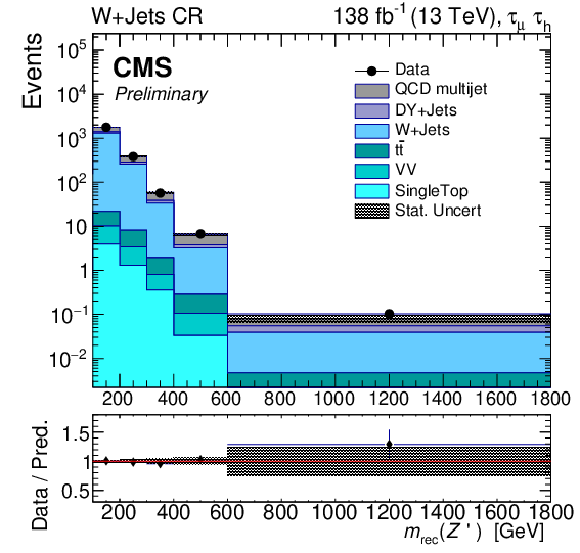
png pdf |
Figure 1-c:
Pre-fit reconstructed mass distributions for the (upper row) τeτh, (middle row and lower row left) τμτh, and (lower row right) τhτh channel. In the upper and middle rows, the W+jets ( t¯t) CR is shown in the left (right) column. The lower row shows the DY CR for the τμτh (τhτh) channel in the left (right) column. The background contributions appear as stacked solid-filled histograms, while the observed data are shown as black solid markers with error bars. Overflow counts are included in the last bin. The grey shadow band represents the statistical uncertainty in the background prediction based on the number of simulated events and scale factor uncertainties. The lower panel of each plot shows the ratio of data to predicted background yields. |
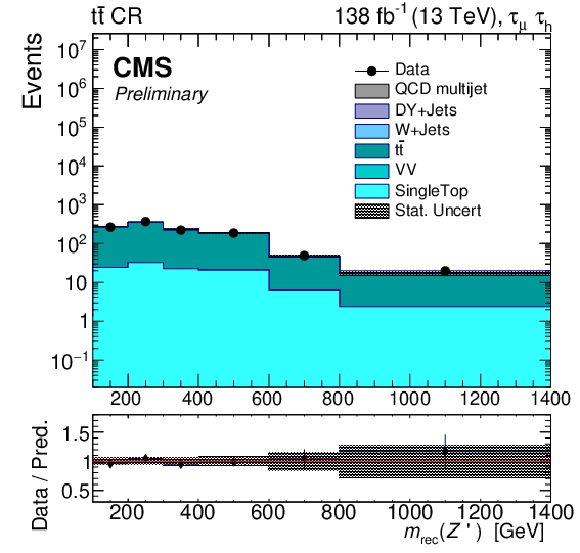
png pdf |
Figure 1-d:
Pre-fit reconstructed mass distributions for the (upper row) τeτh, (middle row and lower row left) τμτh, and (lower row right) τhτh channel. In the upper and middle rows, the W+jets ( t¯t) CR is shown in the left (right) column. The lower row shows the DY CR for the τμτh (τhτh) channel in the left (right) column. The background contributions appear as stacked solid-filled histograms, while the observed data are shown as black solid markers with error bars. Overflow counts are included in the last bin. The grey shadow band represents the statistical uncertainty in the background prediction based on the number of simulated events and scale factor uncertainties. The lower panel of each plot shows the ratio of data to predicted background yields. |
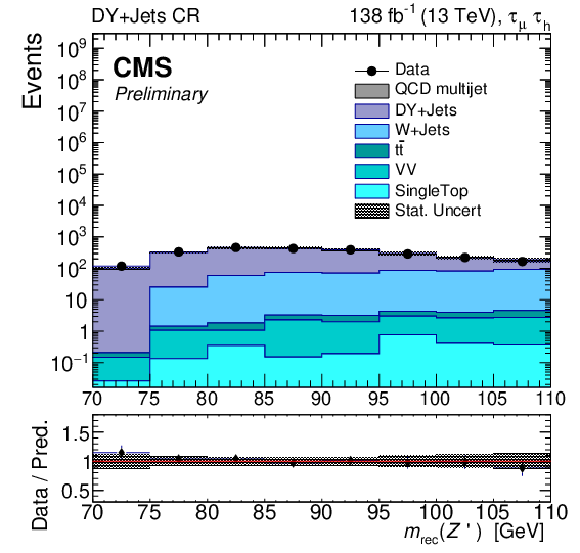
png pdf |
Figure 1-e:
Pre-fit reconstructed mass distributions for the (upper row) τeτh, (middle row and lower row left) τμτh, and (lower row right) τhτh channel. In the upper and middle rows, the W+jets ( t¯t) CR is shown in the left (right) column. The lower row shows the DY CR for the τμτh (τhτh) channel in the left (right) column. The background contributions appear as stacked solid-filled histograms, while the observed data are shown as black solid markers with error bars. Overflow counts are included in the last bin. The grey shadow band represents the statistical uncertainty in the background prediction based on the number of simulated events and scale factor uncertainties. The lower panel of each plot shows the ratio of data to predicted background yields. |
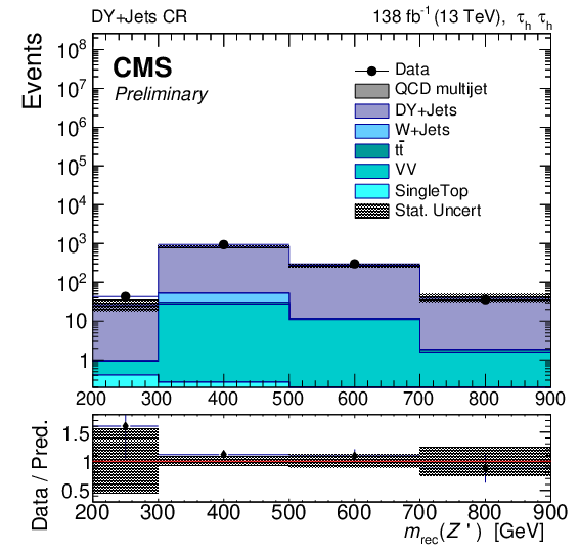
png pdf |
Figure 1-f:
Pre-fit reconstructed mass distributions for the (upper row) τeτh, (middle row and lower row left) τμτh, and (lower row right) τhτh channel. In the upper and middle rows, the W+jets ( t¯t) CR is shown in the left (right) column. The lower row shows the DY CR for the τμτh (τhτh) channel in the left (right) column. The background contributions appear as stacked solid-filled histograms, while the observed data are shown as black solid markers with error bars. Overflow counts are included in the last bin. The grey shadow band represents the statistical uncertainty in the background prediction based on the number of simulated events and scale factor uncertainties. The lower panel of each plot shows the ratio of data to predicted background yields. |

png pdf |
Figure 2:
Pre-fit reconstructed mass distributions for the (upper) τμτh, (middle) τeτh, and (lower) τhτh channel. The background contributions appear as stacked solid-filled histograms, while the observed data are shown as black solid markers with error bars. Overflow counts are included in the last bin. The grey shadow band represents the statistical uncertainty in the background prediction based on the number of simulated events and scale factor uncertainties. The dashed lines correspond to the signal expectation, for Z' masses of 250 GeV (red) and 2500 GeV (magenta), normalized to 1846 pb and 0.1313 pb respectively. |
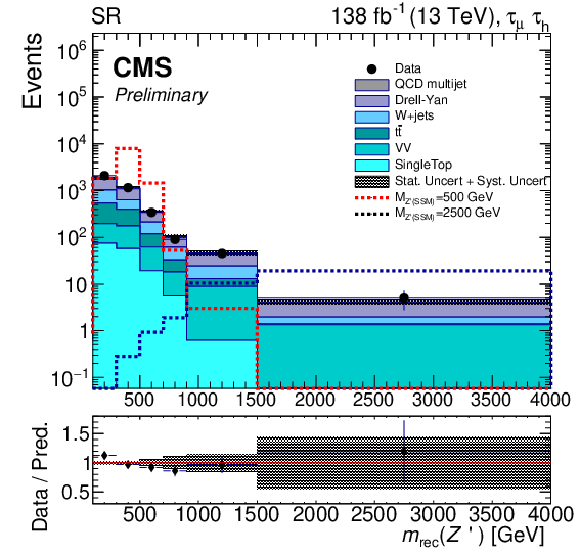
png pdf |
Figure 2-a:
Pre-fit reconstructed mass distributions for the (upper) τμτh, (middle) τeτh, and (lower) τhτh channel. The background contributions appear as stacked solid-filled histograms, while the observed data are shown as black solid markers with error bars. Overflow counts are included in the last bin. The grey shadow band represents the statistical uncertainty in the background prediction based on the number of simulated events and scale factor uncertainties. The dashed lines correspond to the signal expectation, for Z' masses of 250 GeV (red) and 2500 GeV (magenta), normalized to 1846 pb and 0.1313 pb respectively. |

png pdf |
Figure 2-b:
Pre-fit reconstructed mass distributions for the (upper) τμτh, (middle) τeτh, and (lower) τhτh channel. The background contributions appear as stacked solid-filled histograms, while the observed data are shown as black solid markers with error bars. Overflow counts are included in the last bin. The grey shadow band represents the statistical uncertainty in the background prediction based on the number of simulated events and scale factor uncertainties. The dashed lines correspond to the signal expectation, for Z' masses of 250 GeV (red) and 2500 GeV (magenta), normalized to 1846 pb and 0.1313 pb respectively. |
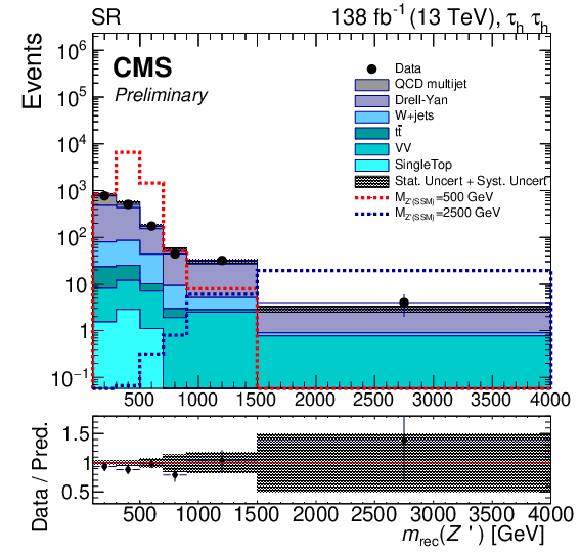
png pdf |
Figure 2-c:
Pre-fit reconstructed mass distributions for the (upper) τμτh, (middle) τeτh, and (lower) τhτh channel. The background contributions appear as stacked solid-filled histograms, while the observed data are shown as black solid markers with error bars. Overflow counts are included in the last bin. The grey shadow band represents the statistical uncertainty in the background prediction based on the number of simulated events and scale factor uncertainties. The dashed lines correspond to the signal expectation, for Z' masses of 250 GeV (red) and 2500 GeV (magenta), normalized to 1846 pb and 0.1313 pb respectively. |

png pdf |
Figure 3:
Upper limits on σB(Z′→τ+τ−) for the (upper) τμτh, (middle) τeτh, and (lower) τhτh channel. In each plot, the solid black line represents the observed limit, and the black dashed line with green and yellow bands gives with the expected limit with its one- and two-standard deviation uncertainties, respectively. The red, pink, and blue dashed lines represent the theoretical predictions for B(Z′→τ+τ−) = 1, 3.37, and 10%, respectively. 3.37% is the same value as in the SM. The assumed B(Z′→τ+τ−) are fixed for all Z' masses. |
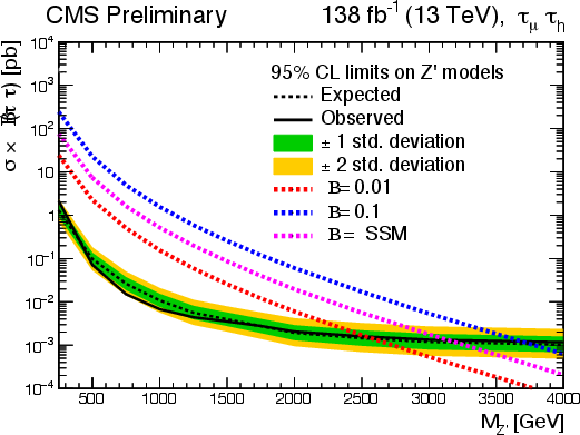
png pdf |
Figure 3-a:
Upper limits on σB(Z′→τ+τ−) for the (upper) τμτh, (middle) τeτh, and (lower) τhτh channel. In each plot, the solid black line represents the observed limit, and the black dashed line with green and yellow bands gives with the expected limit with its one- and two-standard deviation uncertainties, respectively. The red, pink, and blue dashed lines represent the theoretical predictions for B(Z′→τ+τ−) = 1, 3.37, and 10%, respectively. 3.37% is the same value as in the SM. The assumed B(Z′→τ+τ−) are fixed for all Z' masses. |
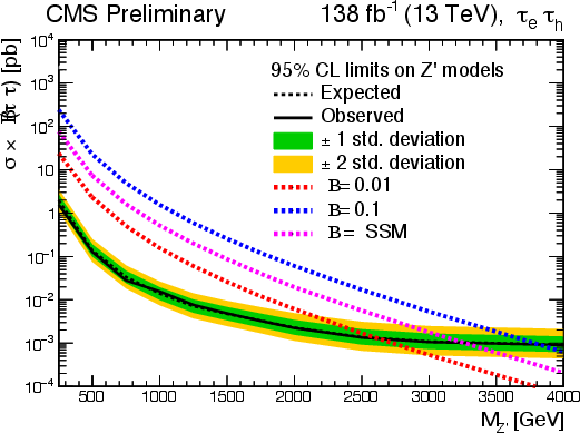
png pdf |
Figure 3-b:
Upper limits on σB(Z′→τ+τ−) for the (upper) τμτh, (middle) τeτh, and (lower) τhτh channel. In each plot, the solid black line represents the observed limit, and the black dashed line with green and yellow bands gives with the expected limit with its one- and two-standard deviation uncertainties, respectively. The red, pink, and blue dashed lines represent the theoretical predictions for B(Z′→τ+τ−) = 1, 3.37, and 10%, respectively. 3.37% is the same value as in the SM. The assumed B(Z′→τ+τ−) are fixed for all Z' masses. |

png pdf |
Figure 3-c:
Upper limits on σB(Z′→τ+τ−) for the (upper) τμτh, (middle) τeτh, and (lower) τhτh channel. In each plot, the solid black line represents the observed limit, and the black dashed line with green and yellow bands gives with the expected limit with its one- and two-standard deviation uncertainties, respectively. The red, pink, and blue dashed lines represent the theoretical predictions for B(Z′→τ+τ−) = 1, 3.37, and 10%, respectively. 3.37% is the same value as in the SM. The assumed B(Z′→τ+τ−) are fixed for all Z' masses. |

png pdf |
Figure 4:
Upper limit on the production cross sections times Z′→τ+τ− branching fraction, for the combination of the three channels. The solid black line represents the observed limit, and the black dashed line with green and yellow bands gives with the expected limit with its one- and two-standard deviation uncertainties, respectively. The red, pink, and blue dashed lines represent the theoretical predictions for values of B(Z′→τ+τ−) = 1, 3.37, and 10%, respectively. 3.37% is the same value as in the SM. The assumed B(Z′→τ+τ−) are fixed for all Z' masses. |
| Tables | |

png pdf |
Table 1:
Pre-fit estimated background and observed event yields for the three channels. For each SM process the yield in events is shown, along with the fractional contribution to the total in percent. |
| Summary |
| A search has been performed in proton-proton collisions at √s= 13 TeV for the production of a Z' boson decaying to τ+τ−. The data were recorded at the LHC during 2016--2018, and correspond to an integrated luminosity of 138 fb−1. As τ leptons can decay hadronically (τh) or leptonically (τℓ), with ℓ representing a muon or electron, the analysis includes the three decay channels with the highest branching fraction products: Z′→τ±μτ∓h, Z′→τ±eτ∓h, and Z′→τ+hτ−h. A discriminating variable mrec(Z′) is constructed to approximate the Z' mass in the presence of undetected neutrino daughters from the τ lepton decays. The principal background processes are estimated using MC simulation with correction factors derived from data. The observed yields are found to be consistent with the background prediction. A shape-based analysis is performed using the mrec(Z′) distribution as the fit discriminant to determine the likelihood of observing signal in the presence of the predicted background rate, given the observed yield in data. An upper limit on the production cross section times Z' decay branching fraction is set at 95% confidence level as a function of the Z' mass. The data exclude a Z' with mass less than 3.0, 3.5, and 4.1 TeV for a branching fraction of 1.0, 3.37, and 10%, respectively. These exclusion limits are the most stringent to date for a Z' decaying to τ+τ−. |
| References | ||||
| 1 | P. K. Mohapatra, R. N. Mohapatra, and P. B. Pal | Implications of E6 Grand Unification | PRD 33 (1986) 2010 | |
| 2 | D. London and J. L. Rosner | Extra Gauge Bosons in E(6) | PRD 34 (1986) 1530 | |
| 3 | L. Randall and R. Sundrum | A Large mass hierarchy from a small extra dimension | --3373, 1999 PRL 83 (1999) 3370 |
hep-ph/9905221 |
| 4 | CMS Collaboration | Search for resonant and nonresonant new phenomena in high-mass dilepton final states at √s = 13 TeV | JHEP 07 (2021) 208 | CMS-EXO-19-019 2103.02708 |
| 5 | ATLAS Collaboration | Search for high-mass dilepton resonances using 139 fb−1 of pp collision data collected at √s=13 TeV with the ATLAS detector | --87, 2019 PLB 796 (2019) 68 |
1903.06248 |
| 6 | P. Langacker | The Physics of Heavy Z′ Gauge Bosons | --1228, 2009 Rev. Mod. Phys. 81 (2009) 1199 |
0801.1345 |
| 7 | K. R. Lynch, E. H. Simmons, M. Narain, and S. Mrenna | Finding Z′ bosons coupled preferentially to the third family at LEP and the Tevatron | PRD 63 (2001) 035006 | hep-ph/0007286 |
| 8 | ATLAS Collaboration | Search for additional heavy neutral Higgs and gauge bosons in the ditau final state produced in 36 fb−1 of pp collisions at √s= 13 TeV with the ATLAS detector | JHEP 01 (2018) 055 | 1709.07242 |
| 9 | CMS Collaboration | Search for heavy resonances decaying to tau lepton pairs in proton-proton collisions at √s= 13 TeV | JHEP 02 (2017) 048 | CMS-EXO-16-008 1611.06594 |
| 10 | BaBar Collaboration | Evidence for an excess of ˉB→D(∗)τ−ˉντ decays | PRL 109 (2012) 101802 | 1205.5442 |
| 11 | BaBar Collaboration | Measurement of an excess of ˉB→D(∗)τ−ˉντ decays and implications for charged Higgs bosons | PRD 88 (2013) 072012 | 1303.0571 |
| 12 | Belle Collaboration | Measurement of the τ lepton polarization and R(D∗) in the decay ˉB→D∗τ−ˉντ with one-prong hadronic τ decays at Belle | PRD 97 (2018) 012004 | 1709.00129 |
| 13 | Belle Collaboration | Measurement of the branching ratio of ˉB0→D∗+τ−ˉντ relative to ˉB0→D∗+ℓ−ˉνℓ decays with a semileptonic tagging method | PRD 94 (2016) 072007 | 1607.07923 |
| 14 | Belle Collaboration | Measurement of the τ lepton polarization and R(D∗) in the decay ˉB→D∗τ−ˉντ | PRL 118 (2017) 211801 | 1612.00529 |
| 15 | Belle Collaboration | Measurement of the branching ratio of ˉB→D(∗)τ−ˉντ relative to ˉB→D(∗)ℓ−ˉνℓ decays with hadronic tagging at Belle | PRD 92 (2015) 072014 | 1507.03233 |
| 16 | LHCb Collaboration | Measurement of the ratio of branching fractions B(ˉB0→D∗+τ−ˉντ)/B(ˉB0→D∗+μ−ˉνμ) | [Erratum: Phys.Rev.Lett. 115, 159901 ()], 2015 PRL 115 (2015) 111803 |
1506.08614 |
| 17 | LHCb Collaboration | Measurement of the ratio of the B0→D∗−τ+ντ and B0→D∗−μ+νμ branching fractions using three-prong τ-lepton decays | PRL 120 (2018) 171802 | 1708.08856 |
| 18 | LHCb Collaboration | Test of lepton flavor universality by the measurement of the B0→D∗−τ+ντ branching fraction using three-prong τ decays | PRD 97 (2018) 072013 | 1711.02505 |
| 19 | R. Diener, S. Godfrey, and T. A. Martin | Unravelling an Extra Neutral Gauge Boson at the LHC using Third Generation Fermions | PRD 83 (2011) 115008 | 1006.2845 |
| 20 | B. Allanach, J. Butterworth, and T. Corbett | Collider constraints on Z′ models for neutral current B anomalies | JHEP 08 (2019) 106 | 1904.10954 |
| 21 | CMS Collaboration | The CMS Experiment at the CERN LHC | JINST 3 (2008) S08004 | |
| 22 | CMS Collaboration | Development of the CMS detector for the CERN LHC Run 3 | JINST 19 (2024) P05064 | |
| 23 | CMS Collaboration | Performance of the CMS Level-1 trigger in proton-proton collisions at √s= 13\,TeV | JINST 15 (2020) P10017 | CMS-TRG-17-001 2006.10165 |
| 24 | CMS Collaboration | The CMS trigger system | JINST 12 (2017) P01020 | CMS-TRG-12-001 1609.02366 |
| 25 | CMS Collaboration | Particle-flow reconstruction and global event description with the CMS detector | JINST 12 (2017) P10003 | CMS-PRF-14-001 1706.04965 |
| 26 | CMS Collaboration | Technical proposal for the Phase-II upgrade of the Compact Muon Solenoid | CMS Technical Proposal CERN-LHCC-2015-010, CMS-TDR-15-02, 2015 CDS |
|
| 27 | CMS Collaboration | Performance of the CMS muon detector and muon reconstruction with proton-proton collisions at √s= 13 TeV | JINST 13 (2018) P06015 | CMS-MUO-16-001 1804.04528 |
| 28 | CMS Collaboration | Electron and photon reconstruction and identification with the CMS experiment at the CERN LHC | JINST 16 (2021) P05014 | CMS-EGM-17-001 2012.06888 |
| 29 | CMS Collaboration | Reconstruction of signal amplitudes in the CMS electromagnetic calorimeter in the presence of overlapping proton-proton interactions | JINST 15 (2020) P10002 | CMS-EGM-18-001 2006.14359 |
| 30 | CMS Collaboration | Performance of reconstruction and identification of τ leptons decaying to hadrons and ντ in pp collisions at √s= 13 TeV | JINST 13 (2018) P10005 | CMS-TAU-16-003 1809.02816 |
| 31 | CMS Collaboration | Identification of hadronic tau lepton decays using a deep neural network | JINST 17 (2022) P07023 | CMS-TAU-20-001 2201.08458 |
| 32 | M. Cacciari, G. P. Salam, and G. Soyez | The anti-kt jet clustering algorithm | JHEP 04 (2008) 063 | 0802.1189 |
| 33 | M. Cacciari, G. P. Salam, and G. Soyez | FastJet user manual | EPJC 72 (2012) 1896 | 1111.6097 |
| 34 | CMS Collaboration | Identification of heavy-flavour jets with the CMS detector in pp collisions at 13 TeV | JINST 13 (2018) P05011 | CMS-BTV-16-002 1712.07158 |
| 35 | CMS Collaboration | Performance of missing transverse momentum reconstruction in proton-proton collisions at √s= 13\,TeV using the CMS detector | JINST 14 (2019) P07004 | CMS-JME-17-001 1903.06078 |
| 36 | J. Alwall et al. | The automated computation of tree-level and next-to-leading order differential cross sections, and their matching to parton shower simulations | JHEP 07 (2014) 079 | 1405.0301 |
| 37 | S. Alioli, P. Nason, C. Oleari, and E. Re | A general framework for implementing NLO calculations in shower Monte Carlo programs: the POWHEG BOX | JHEP 06 (2010) 043 | 1002.2581 |
| 38 | T. Sjostrand et al. | An introduction to pythia 8.2 | --177, 2015 Computer Physics Communications 191 (2015) 159 |
|
| 39 | CMS Collaboration | Event generator tunes obtained from underlying event and multiparton scattering measurements | EPJC 76 (2016) 155 | CMS-GEN-14-001 1512.00815 |
| 40 | CMS Collaboration | Extraction and validation of a new set of CMS PYTHIA8 tunes from underlying-event measurements | EPJC 80 (2020) 4 | CMS-GEN-17-001 1903.12179 |
| 41 | NNPDF Collaboration | Parton distributions for the LHC run II | JHEP 04 (2015) 040 | 1410.8849 |
| 42 | S. Alioli, P. Nason, C. Oleari, and E. Re | NLO single-top production matched with shower in POWHEG: s- and t-channel contributions | JHEP 09 (2009) 111 | 0907.4076 |
| 43 | E. Re | Single-top Wt-channel production matched with parton showers using the POWHEG method | EPJC 71 (2011) 1547 | 1009.2450 |
| 44 | T. Melia, P. Nason, R. Rontsch, and G. Zanderighi | W+W−, WZ and ZZ production in the POWHEG BOX | JHEP 11 (2011) 078 | 1107.5051 |
| 45 | M. Beneke, P. Falgari, S. Klein, and C. Schwinn | Hadronic top-quark pair production with NNLL threshold resummation | NPB 855 (2012) 695 | 1109.1536 |
| 46 | M. Cacciari et al. | Top-pair production at hadron colliders with next-to-next-to-leading logarithmic soft-gluon resummation | PLB 710 (2012) 612 | 1111.5869 |
| 47 | P. B ä rnreuther, M. Czakon, and A. Mitov | Percent level precision physics at the Tevatron: first genuine NNLO QCD corrections to q¯q→t¯t+X | PRL 109 (2012) 132001 | 1204.5201 |
| 48 | M. Czakon and A. Mitov | NNLO corrections to top-pair production at hadron colliders: the all-fermionic scattering channels | JHEP 12 (2012) 054 | 1207.0236 |
| 49 | M. Czakon and A. Mitov | NNLO corrections to top pair production at hadron colliders: the quark-gluon reaction | JHEP 01 (2013) 080 | 1210.6832 |
| 50 | M. Czakon, P. Fiedler, and A. Mitov | Total top-quark pair-production cross section at hadron colliders through O(α4S) | PRL 110 (2013) 252004 | 1303.6254 |
| 51 | R. Gavin, Y. Li, F. Petriello, and S. Quackenbush | W physics at the LHC with FEWZ 2.1 | Comput. Phys. Commun. 184 (2013) 208 | 1201.5896 |
| 52 | R. Gavin, Y. Li, F. Petriello, and S. Quackenbush | FEWZ 2.0: A code for hadronic Z production at next-to-next-to-leading order | Comput. Phys. Commun. 182 (2011) 2388 | 1011.3540 |
| 53 | GEANT4 Collaboration | GEANT 4---a simulation toolkit | NIM A 506 (2003) 250 | |
| 54 | CMS Collaboration | Precision luminosity measurement in proton-proton collisions at √s= 13 TeV in 2015 and 2016 at CMS | EPJC 81 (2021) 800 | CMS-LUM-17-003 2104.01927 |
| 55 | CMS Collaboration | CMS luminosity measurement for the 2017 data-taking period at √s = 13 TeV | CMS Physics Analysis Summary, 2018 link |
CMS-PAS-LUM-17-004 |
| 56 | CMS Collaboration | CMS luminosity measurement for the 2018 data-taking period at √s = 13 TeV | CMS Physics Analysis Summary, 2019 link |
CMS-PAS-LUM-18-002 |
| 57 | CMS Collaboration | Measurement of the inelastic proton-proton cross section at √s= 13 TeV | JHEP 07 (2018) 161 | CMS-FSQ-15-005 1802.02613 |
| 58 | ATLAS Collaboration | Measurement of the inelastic proton-proton cross section at √s= 13 TeV with the ATLAS detector at the LHC | PRL 117 (2016) 182002 | 1606.02625 |
| 59 | CMS Collaboration | Performance of b--jet identification in CMS | JINST 8 (2013) P04013 | |
| 60 | J. Butterworth et al. | PDF4LHC recommendations for LHC Run II | JPG 43 (2016) 023001 | 1510.03865 |
| 61 | M. Cacciari et al. | The t anti-t cross-section at 1.8-TeV and 1.96-TeV: A Study of the systematics due to parton densities and scale dependence | JHEP 04 (2004) 068 | hep-ph/0303085 |
| 62 | CMS Collaboration | The CMS statistical analysis and combination tool: \textscCombine | Submitted to Comput. Softw. Big Sci, 2024 | CMS-CAT-23-001 2404.06614 |
| 63 | T. Junk | Confidence level computation for combining searches with small statistics | NIM A 434 (1999) 435 | hep-ex/9902006 |
| 64 | A. L. Read | Presentation of search results: the CLs technique | JPG 28 (2002) 2693 | |

|
Compact Muon Solenoid LHC, CERN |

|

|

|

|

|

|